Effect of Ti Addition on the Precipitation Mechanism and Precipitate Size in Nb-Microalloyed Steels
Abstract
1. Introduction
2. Experimental Materials and Methods
3. Results and Discussion
4. Conclusions
- (1)
- Ti addition changes the precipitation mechanism of NbC particles in Nb-microalloyed steels. Nucleation and subsequent growth are the dominant precipitation mechanisms of NbC particles in Nb-microalloyed steel, while they change to epitaxial growth of NbC particles attached to pre-existing TiN in Ti-Nb-microalloyed steel.
- (2)
- The average size of the NbC precipitates is 54.1 nm, and the volume fraction is 0.0128% in Nb-microalloyed steel, while the corresponding values are 25.4 nm and 0.095%, respectively, in Ti-Nb-microalloyed steel. That is, the complex structure of TiN–NbC particles usually has a smaller size and more dispersed distribution in Ti-Nb-microalloyed steel than in Nb-microalloyed steel.
- (3)
- NbC particles may not be completely precipitated via a strain-induced precipitation mechanism, especially when the strain accumulation is not large enough, while Ti addition can effectively promote the precipitation of NbC particles.
Author Contributions
Funding
Data Availability Statement
Acknowledgments
Conflicts of Interest
References
- Gu, L.H.; Li, S.L.; Liu, C.M.; Liu, J.G.; Zhang, S.Y.; Chu, R.S.; Ma, C.W. Development and application of super heavy gauge high-strength structural steel for high-rise buildings. IOP Conf. Ser. Mate. Sci. Eng. 2017, 242, 012062. [Google Scholar] [CrossRef]
- Samie, N.N. Disciplines involved in offshore platform design. In Practical Engineering Management of Offshore Oil and Gas Platforms; Gulf Professional Publishing: Cambridge, MA, USA, 2016; pp. 25–212. [Google Scholar] [CrossRef]
- Wang, B.; Wang, Z.D.; Wang, B.X.; Wang, G.D.; Misra, R.D.K. The relationship between microstructural evolution and mechanical properties of heavy plate of low-Mn steel during ultra fast cooling. Metall. Mater. Trans. A 2015, 46, 2834–2843. [Google Scholar] [CrossRef][Green Version]
- Kitani, Y.; Ikeda, R.; Ono, M.; Ikeuchi, K. Improvement of Weld Metal Toughness in High Heat Input Electro-Slag Welding of Low Carbon Steel, Weld. World 2009, 53, R57–R63. [Google Scholar] [CrossRef]
- Yoon, J.I.; Jung, J.; Joo, S.H.; Song, T.J.; Chin, K.G.; Seo, M.H.; Kim, S.J.; Lee, S.; Kim, H.S. Correlation between fracture toughness and stretch-flangeability of advanced high strength steels. Mater. Lett. 2016, 180, 322–326. [Google Scholar] [CrossRef]
- Todic, A.; Cikara, D.; Todic, T.; Cikara-Anic, D.; Minic, D. Influence of chemical composition on the structure, hardness and toughness of high alloyed Cr-Mo-V steel. Mater. Manuf. Process. 2012, 27, 1193–1197. [Google Scholar] [CrossRef]
- Pourazizi, R.; Davani, R.K.Z.; Mohtadi-Bonab, M.A.; Szpunar, J.A. Evolution of microstructure and texture in pipeline steels at different TMCP procedures with regard to hydrogen induced cracking. Int. J. Hydrogen Energy 2021, 46, 38741–38754. [Google Scholar] [CrossRef]
- El-Shenawy, E.; Reda, R. Optimization of TMCP strategy for microstructure refinement and flow-productivity characteristics enhancement of low carbon steel. J. Mater. Res. Technol. 2019, 8, 2819–2831. [Google Scholar] [CrossRef]
- Zhu, G.; Subramanian, S.V. Ultra-fine grain size control and mixed grains elimination in industrial multi-pass rolling processing. Mater. Sci. Eng. A 2006, 426, 235–239. [Google Scholar] [CrossRef]
- Zhu, G.H.; Subramanian, S.V. Recrystallization behavior design for controlling grain size in strip rolling process. J. Iron Steel Res. Int. 2008, 15, 39–44. [Google Scholar] [CrossRef]
- Ding, H.L.; Zhu, G.H.; Chen, Q.W.; Wang, Y.Q.; Wang, X.N. Mechanism of boundary induced transformation and its application in the grain refinement of large-size structural steels. Mater. Sci. Eng. A 2021, 818, 141342. [Google Scholar] [CrossRef]
- Wang, Y.; Li, J.; Li, F.; Ge, Z.; Xing, J.; Li, N.; Zhu, G.; Ding, H.; Chen, Q. The important role of titanium microalloying in refining austenite grain of heavy-duty H-beam steel during rough rolling produced by a new technology. Mater. Sci. Eng. Technol. 2021, 52, 781–791. [Google Scholar] [CrossRef]
- Capurro, C.; Cicutti, C. Analysis of titanium nitrides precipitated during medium carbon steels solidification. J. Mater. Res. Technol. 2018, 7, 342–349. [Google Scholar] [CrossRef]
- Xing, L.; Guo, J.; Li, X.; Zhang, Z.; Wang, M.; Bao, Y. Control of TiN precipitation behavior in titanium-containing micro-alloyed steel. Mater. Today Commun. 2020, 25, 101292. [Google Scholar] [CrossRef]
- Moon, J.; Lee, C.; Uhm, S.; Lee, J. Coarsening kinetics of TiN particle in a low alloyed steel in weld HAZ: Considering critical particle size. Acta Mater. 2006, 54, 1053–1061. [Google Scholar] [CrossRef]
- Medina, S.; Chapa, M.; Valles, P.; Ouispe, A.; Vega, M. Influence of Ti and N contents on austenite grain control and precipitate size in structural steels. ISIJ Int. 1999, 39, 930–936. [Google Scholar] [CrossRef]
- Craven, A.J.; He, K.; Garvie, L.A.J.; Baker, T.N. Complex heterogeneous precipitation in titanium–niobium microalloyed Al-killed HSLA steels—I. (Ti,Nb)(C,N) particles. Acta Mater. 2000, 48, 3857–3868. [Google Scholar] [CrossRef]
- Ma, X.; Miao, C.; Langelier, B.; Subramanian, S. Suppression of strain-induced precipitation of NbC by epitaxial growth of NbC on pre-existing TiN in Nb-Ti microalloyed steel. Mater. Design. 2017, 132, 244–249. [Google Scholar] [CrossRef]
- Gui, L.; Long, M.; Zhang, H.; Chen, D.; Liu, S.; Wang, Q.; Duan, H. Study on the precipitation and coarsening of TiN inclusions in Ti-microalloyed steel by a modified coupling model. J. Mater. Res. Technol. 2020, 9, 5499–5514. [Google Scholar] [CrossRef]
- McCall, J.L.; Boyd, J.E. Quantitative metallography of dispersion-strengthened alloys from extraction replicas-volume fraction and interparticle spacing. In Proceedings of the First Annual Technical Meeting of the International Metallographic Society, Denver, CO, USA, 8 September 1969; pp. 153–155. [Google Scholar]
- Seher, R.J.; Maniar, G.N. Analytical-preshadowed extraction replica technique. Metallography 1972, 5, 409–414. [Google Scholar] [CrossRef]
- Matsuda, S.; Okumura, N. Effect of distribution of TiN precipitate particles on the austenite grain size of low carbon low alloy steels. ISIJ Int. 1978, 18, 198–205. [Google Scholar] [CrossRef]
- Wada, H.; Pehlke, R.D. Nitrogen solubility and nitride formation in austenitic Fe-Ti alloys. Metall. Mater. Trans. B 1985, 16, 815–822. [Google Scholar] [CrossRef]
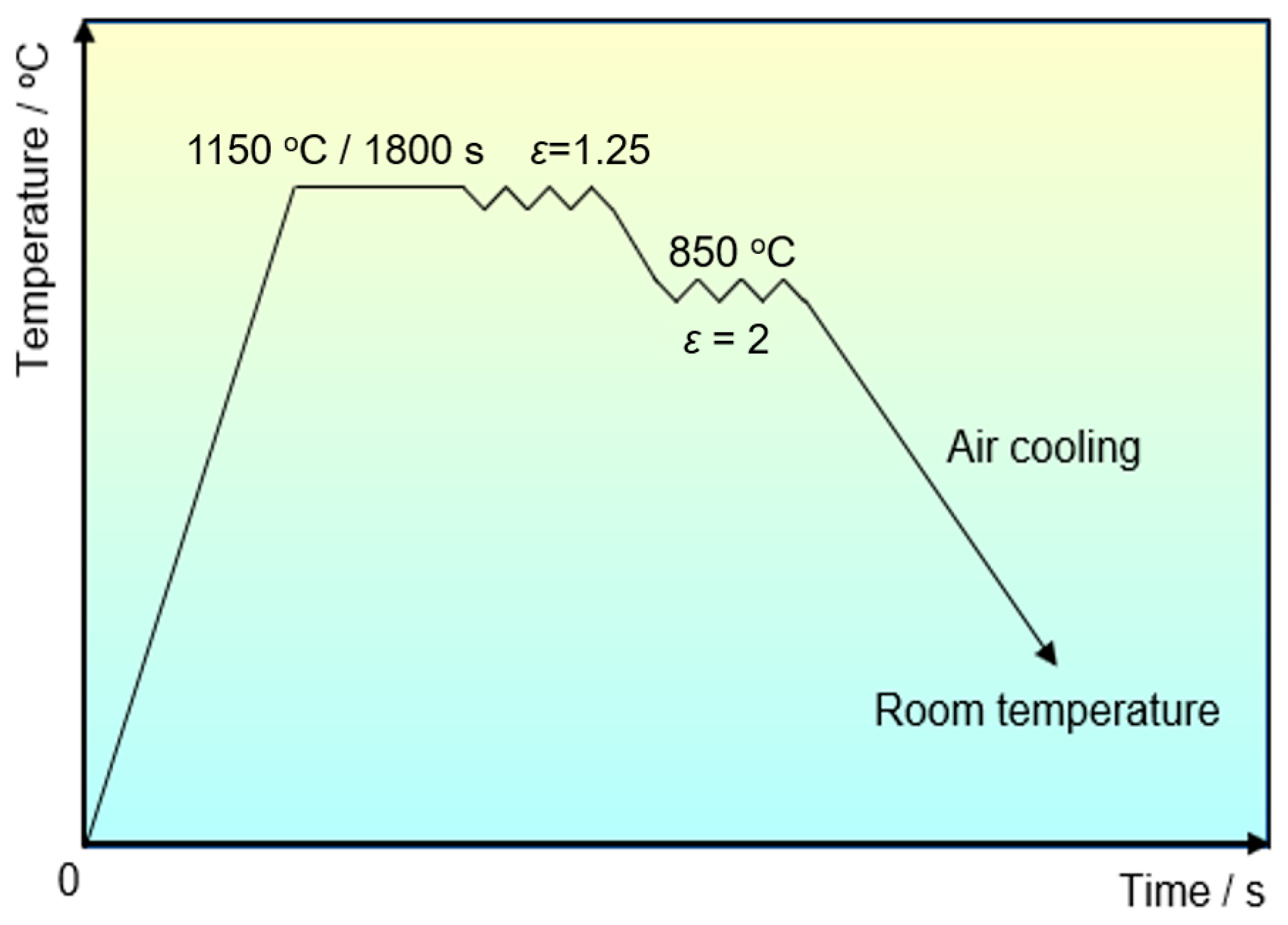

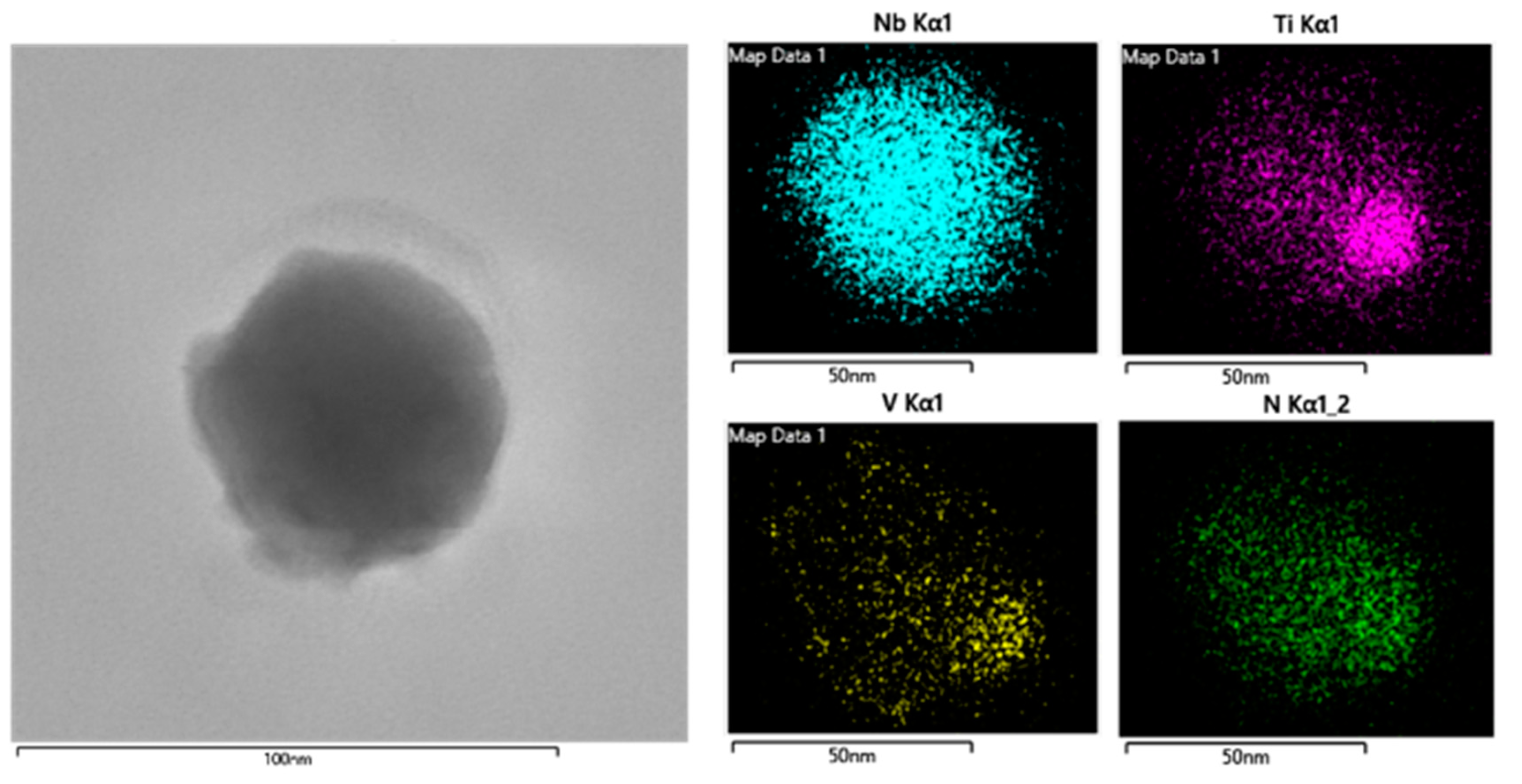
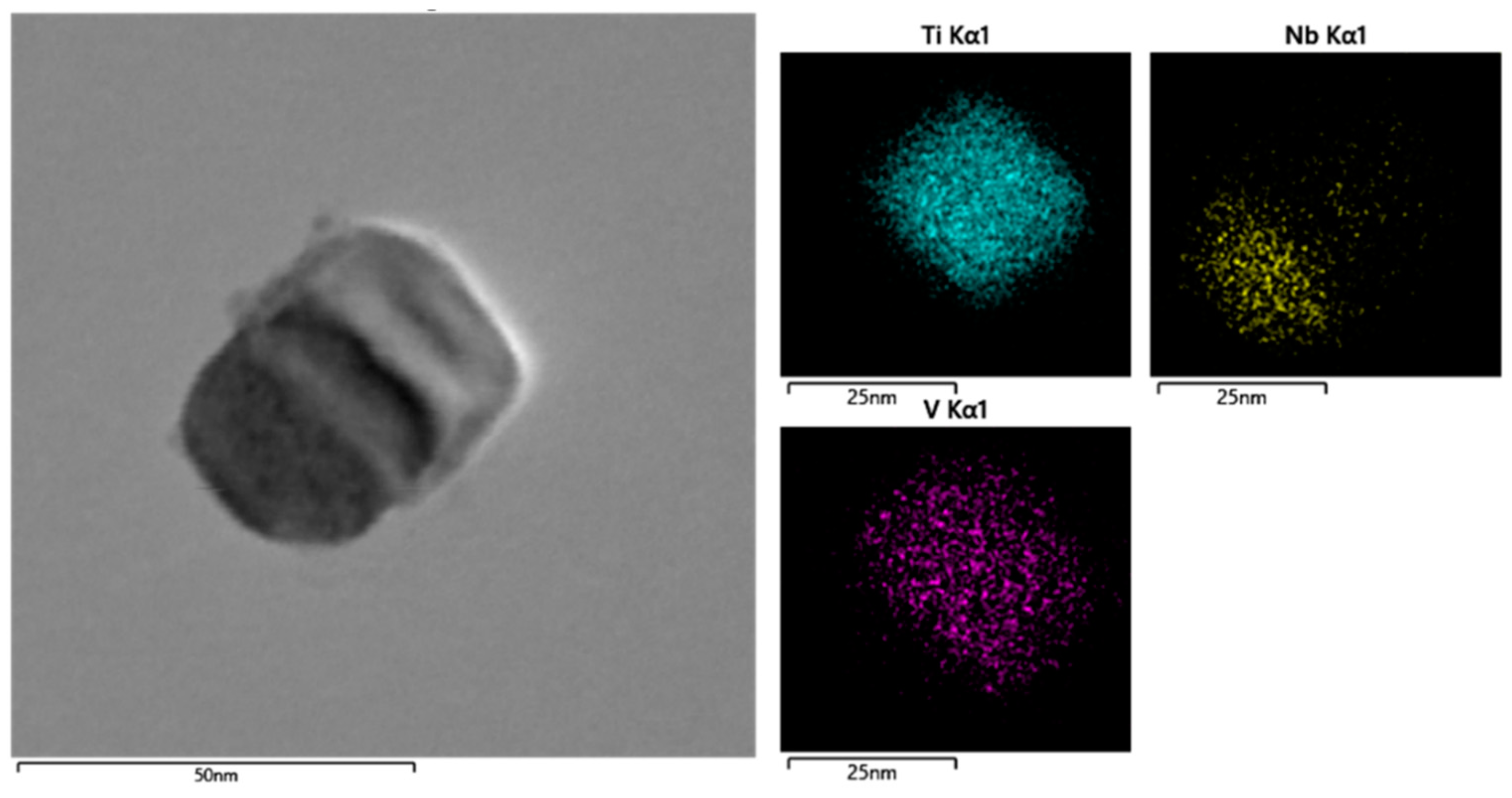
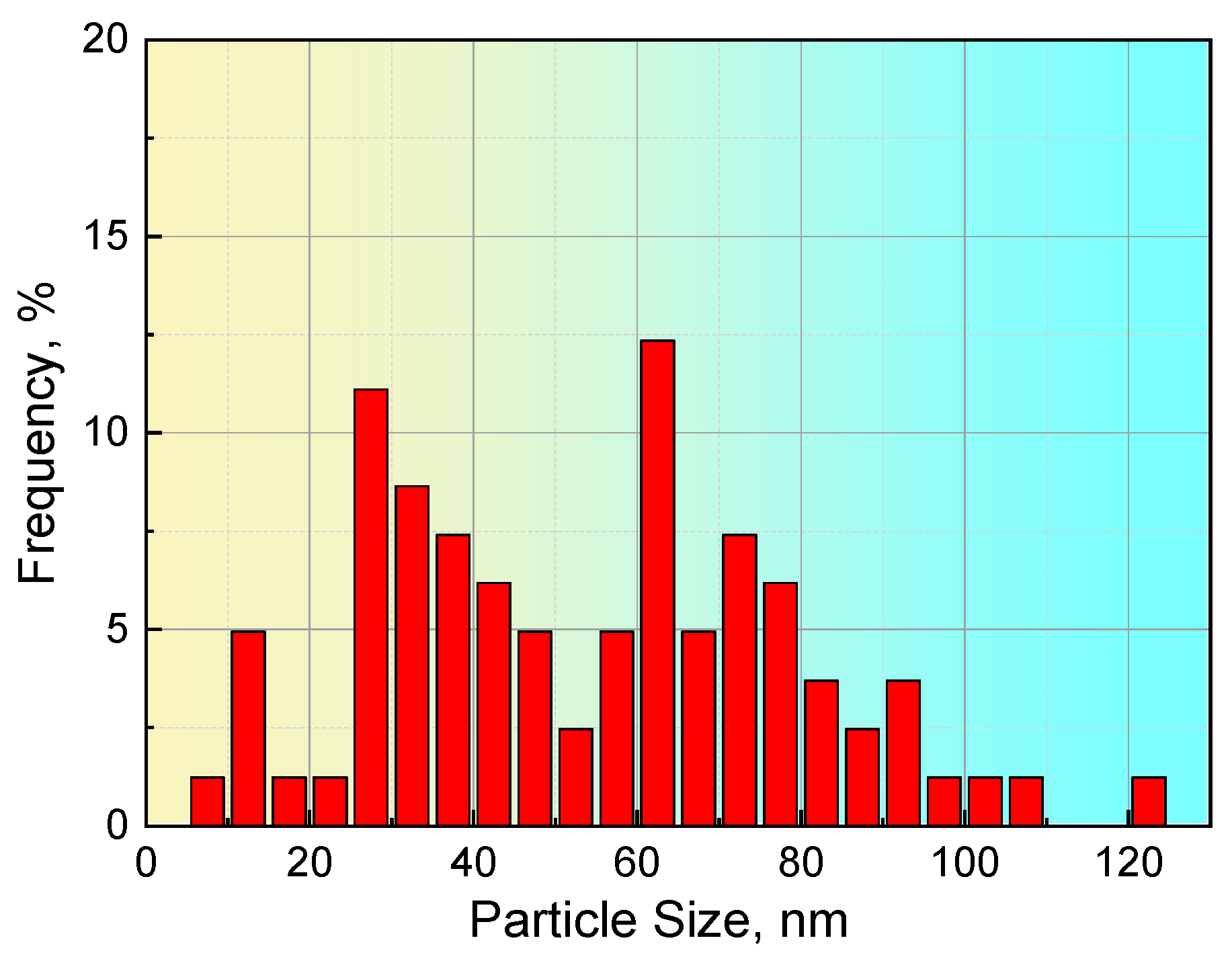
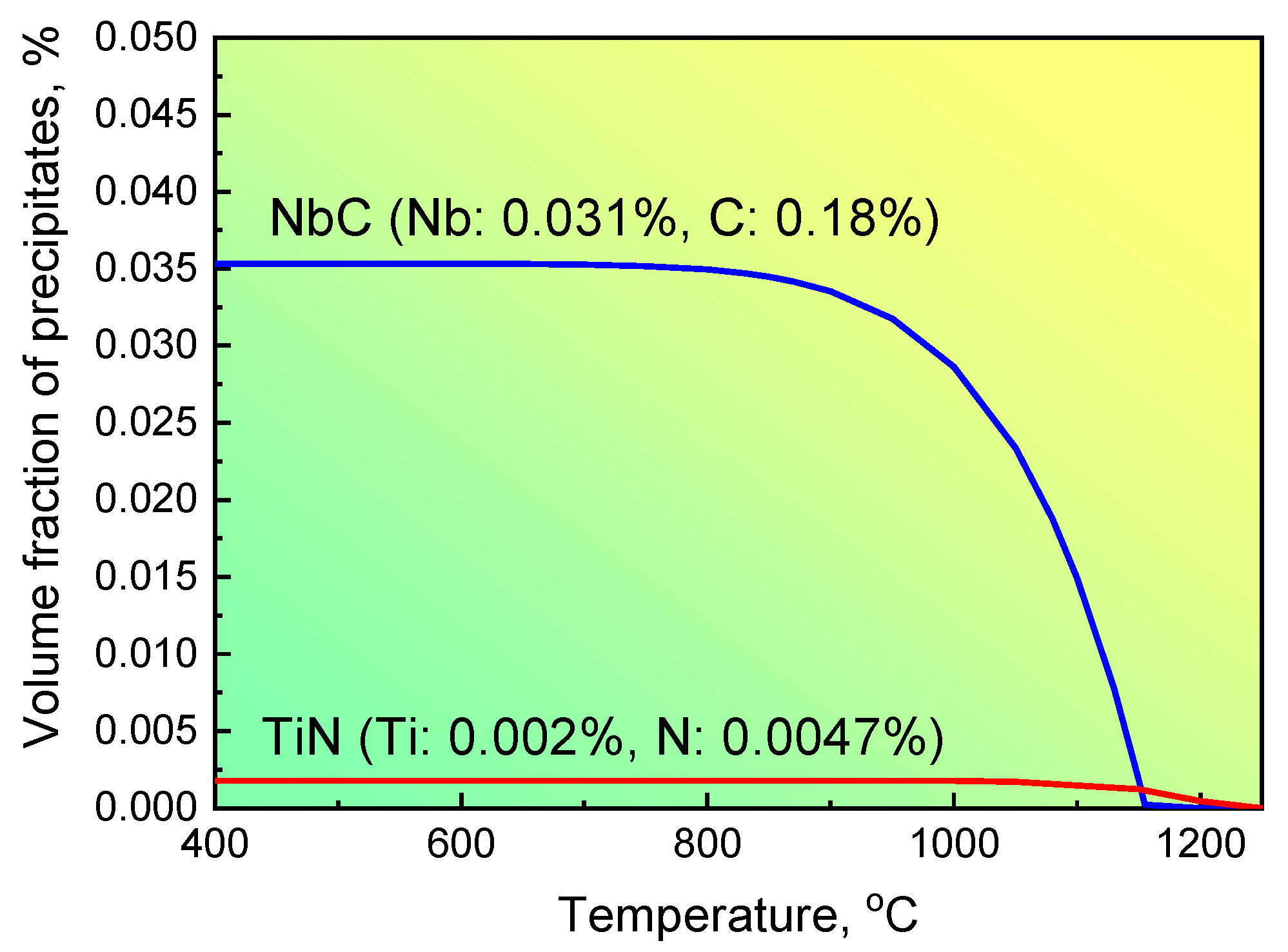
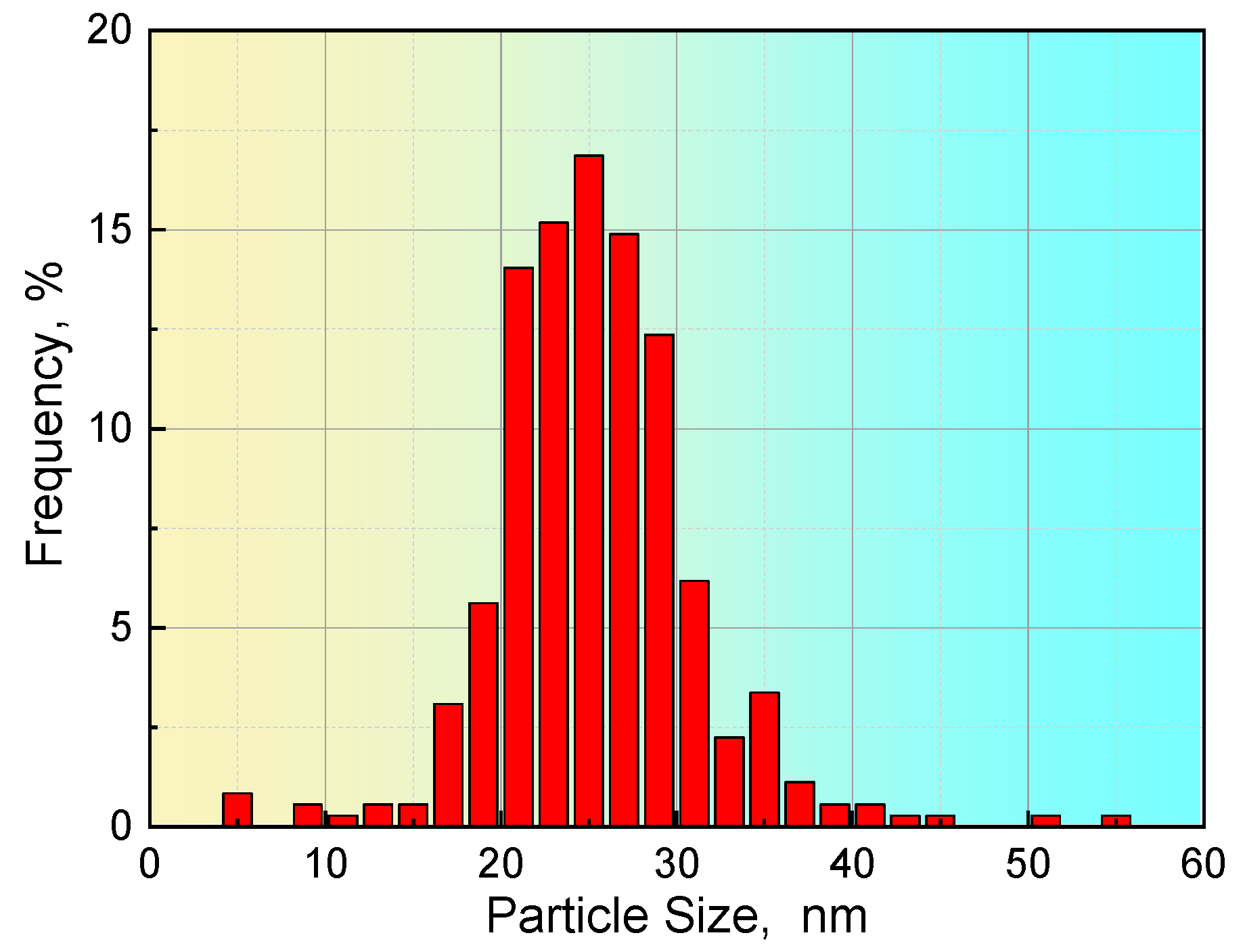
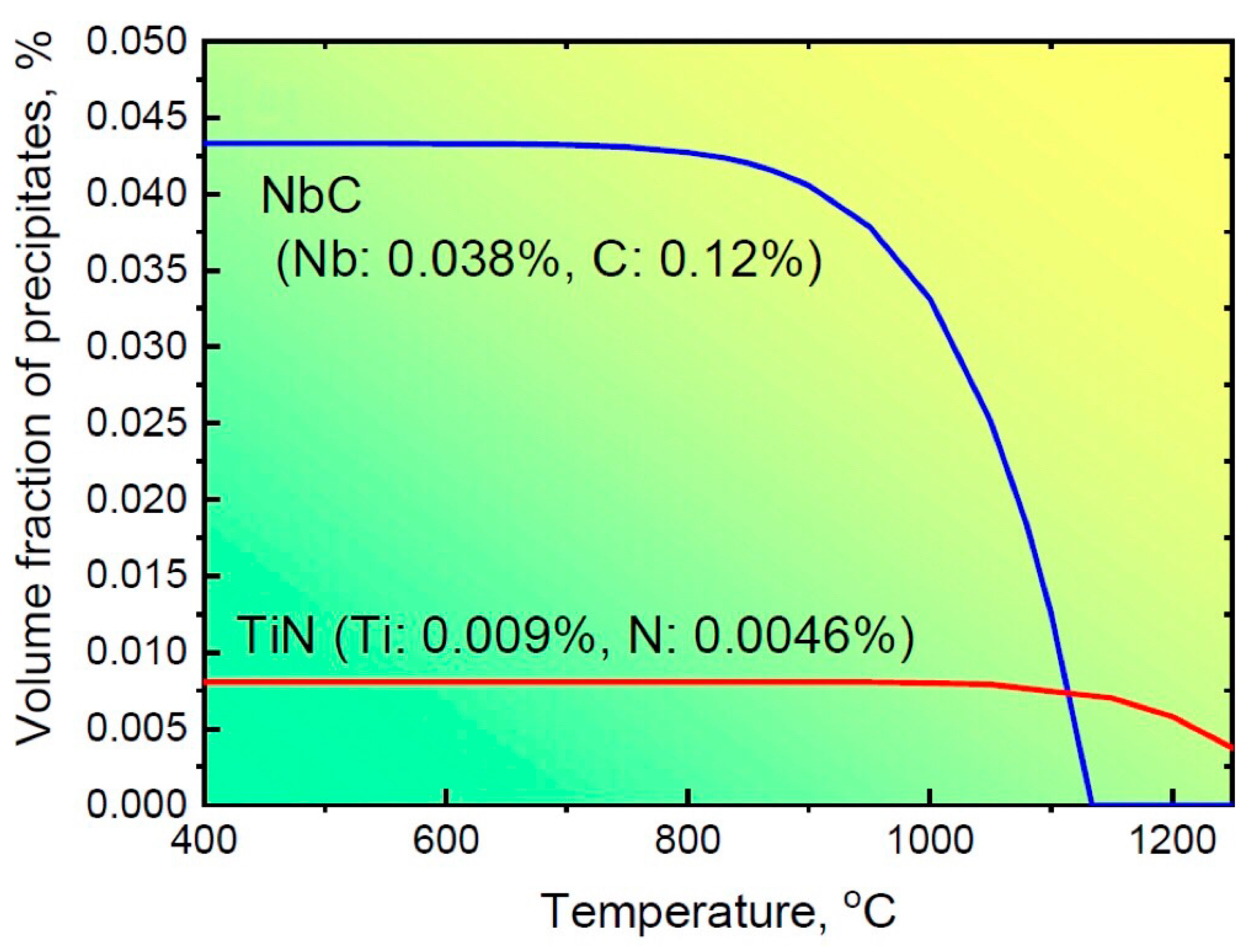
| Steels | C | Mn | Si | P | S | Ti | Nb | V | Al | N |
|---|---|---|---|---|---|---|---|---|---|---|
| S1 | 0.18 | 1.51 | 0.54 | 0.006 | 0.003 | 0.002 | 0.031 | 0.023 | 0.012 | 0.0047 |
| S2 | 0.12 | 1.49 | 0.31 | 0.004 | 0.003 | 0.009 | 0.038 | 0.034 | 0.013 | 0.0046 |
| Class | ECD (µm) | Ti (wt.%) | V (wt.%) | Nb (wt.%) |
|---|---|---|---|---|
| TiVNb | 0.061678 | 2.916971 | 1.943436 | 59.36655 |
| VNb | 0.09212 | - | 1.024304 | 1.433306 |
| TiVNb | 0.092586 | 4.130418 | 1.924443 | 57.43785 |
| TiVNb | 0.064408 | 1.74785 | 2.035784 | 54.06454 |
| VNb | 0.065468 | - | 2.897306 | 49.08118 |
| VNb | 0.062784 | - | 4.321418 | 46.55011 |
| TiVNb | 0.070164 | 1.636067 | 1.092925 | 59.78169 |
| TiVNb | 0.056887 | 1.221049 | 1.176167 | 60.00959 |
| TiVNb | 0.086033 | 1.787149 | 1.115035 | 63.06081 |
| TiVNb | 0.070653 | 1.356135 | 1.294701 | 54.77613 |
| TiVNb | 0.057638 | 1.54289 | 1.727562 | 51.45393 |
| TiVNb | 0.062647 | 1.074376 | 3.604971 | 49.94766 |
| TiVNb | 0.068927 | 2.083507 | 1.738859 | 49.53244 |
| TiVNb | 0.047122 | 1.339961 | 2.881639 | 40.23057 |
| Class | ECD (µm) | Ti (wt.%) | V (wt.%) | Nb (wt.%) |
|---|---|---|---|---|
| TiVNb | 0.0338 | 20.42 | 4.30 | 40.30 |
| TiVNb | 0.0324 | 13.21 | 3.24 | 43.05 |
| TiVNb | 0.0256 | 15.82 | 5.26 | 40.26 |
| TiVNb | 0.0298 | 15.81 | 4.34 | 35.67 |
| TiVNb | 0.0401 | 22.25 | 3.67 | 40.63 |
| TiVNb | 0.0266 | 8.75 | 2.69 | 41.18 |
| TiVNb | 0.0222 | 13.57 | 5.16 | 28.19 |
| TiVNb | 0.0255 | 12.67 | 5.56 | 38.87 |
| TiVNb | 0.0272 | 16.04 | 4.93 | 31.57 |
| TiVNb | 0.0235 | 14.32 | 5.25 | 32.04 |
| TiVNb | 0.0243 | 12.40 | 5.47 | 28.69 |
| TiVNb | 0.0271 | 8.61 | 3.15 | 41.19 |
| TiVNb | 0.0298 | 16.72 | 4.89 | 30.29 |
| TiVNb | 0.0274 | 8.81 | 4.18 | 41.79 |
| TiVNb | 0.0298 | 16.89 | 5.96 | 29.86 |
| TiVNb | 0.0327 | 11.44 | 4.56 | 33.77 |
| TiVNb | 0.0250 | 13.39 | 6.17 | 28.91 |
| TiN | 0.0319 | 4.57 | - | - |
| TiN | 0.0287 | 5.88 | - | - |
| No | Number | Category | Size(µm) | Ti (wt.%) | V (wt.%) | Nb (wt.%) |
|---|---|---|---|---|---|---|
| 1 | 9 | Min | 0.0093 | 0 | 0.065 | 0 |
| Max | 0.1076 | 3.423 | 12.321 | 65.854 | ||
| Mean | 0.0748 | 1.716 | 3.085 | 48.450 | ||
| 2 | 14 | Min | 0.0471 | 0 | 1.093 | 1.433 |
| Max | 0.0926 | 4.130 | 4.321 | 63.061 | ||
| Mean | 0.0685 | 1.488 | 2.055 | 49.766 | ||
| 3 | 7 | Min | 0.0535 | 1.372 | 1.042 | 59.221 |
| Max | 0.0757 | 3.772 | 2.031 | 66.196 | ||
| Mean | 0.0662 | 2.837 | 1.369 | 62.549 | ||
| 4 | 5 | Min | 0.0380 | 1.562 | 1.057 | 49.157 |
| Max | 0.0762 | 5.421 | 2.353 | 60.091 | ||
| Mean | 0.0648 | 3.589 | 1.457 | 56.521 | ||
| 5 | 6 | Min | 0.0550 | 0 | 1.223 | 39.416 |
| Max | 0.0827 | 8.229 | 2.625 | 56.854 | ||
| Mean | 0.0692 | 4.380 | 1.733 | 48.848 | ||
| 6 | 9 | Min | 0.0117 | 2.699 | 0 | 0 |
| Max | 0.0841 | 40.391 | 4.261 | 60.992 | ||
| Mean | 0.0367 | 15.991 | 1.464 | 42.004 | ||
| 7 | 17 | Min | 0.0195 | 1.089 | 1.005 | 39.128 |
| Max | 0.1218 | 32.832 | 9.138 | 62.216 | ||
| Mean | 0.0438 | 11.343 | 3.053 | 47.082 | ||
| 8 | 3 | Min | 0.0117 | 2.991 | 1.991 | 39.755 |
| Max | 0.0489 | 16.257 | 4.665 | 57.554 | ||
| Mean | 0.0344 | 9.150 | 3.698 | 47.648 | ||
| 9 | 2 | Min | 0.0327 | 2.944 | 1.118 | 49.830 |
| Max | 0.0834 | 16.450 | 2.620 | 57.645 | ||
| Mean | 0.0580 | 9.697 | 1.869 | 53.734 | ||
| 10 | 1 | - | 0.0256 | 18.88 | 1.992 | 48.615 |
| 11 | 8 | Min | 0.0138 | 0 | 1.095 | 6.650 |
| Max | 0.0282 | 38.829 | 5.628 | 55.818 | ||
| Mean | 0.0285 | 10.921 | 2.843 | 41.572 |
| No | Number | Category | Size (μm) | Ti (wt.%) | V (wt.%) | Nb (wt.%) |
|---|---|---|---|---|---|---|
| 1 | 23 | Min | 0.0055 | 4.478 | 0 | 0 |
| Max | 0.0402 | 38.839 | 8.337 | 50.396 | ||
| Mean | 0.0240 | 13.503 | 4.161 | 27.137 | ||
| 2 | 51 | Min | 0.0169 | 2.691 | 0 | 0 |
| Max | 0.0547 | 33.021 | 6.297 | 43.046 | ||
| Mean | 0.0288 | 11.577 | 3.705 | 25.912 | ||
| 3 | 62 | Min | 0.0138 | 7.155 | 1.709 | 20.783 |
| Max | 0.0507 | 34.159 | 7.276 | 46.006 | ||
| Mean | 0.0270 | 15.276 | 5.017 | 34.843 | ||
| 4 | 77 | Min | 0.0046 | 0 | 0 | 2.861 |
| Max | 0.0363 | 23.357 | 7.132 | 42.568 | ||
| Mean | 0.0241 | 12.880 | 4.846 | 32.551 | ||
| 5 | 91 | Min | 0.0059 | 7.503 | 3.751 | 22.347 |
| Max | 0.0363 | 26.323 | 7.938 | 45.037 | ||
| Mean | 0.0234 | 14.438 | 5.178 | 35.593 | ||
| 6 | 52 | Min | 0.0162 | 5.180 | 2.936 | 19.270 |
| Max | 0.0393 | 21.630 | 7.172 | 40.043 | ||
| Mean | 0.0254 | 13.561 | 4.691 | 30.488 |
Publisher’s Note: MDPI stays neutral with regard to jurisdictional claims in published maps and institutional affiliations. |
© 2022 by the authors. Licensee MDPI, Basel, Switzerland. This article is an open access article distributed under the terms and conditions of the Creative Commons Attribution (CC BY) license (https://creativecommons.org/licenses/by/4.0/).
Share and Cite
Xing, J.; Zhu, G.; Wu, B.; Ding, H.; Pan, H. Effect of Ti Addition on the Precipitation Mechanism and Precipitate Size in Nb-Microalloyed Steels. Metals 2022, 12, 245. https://doi.org/10.3390/met12020245
Xing J, Zhu G, Wu B, Ding H, Pan H. Effect of Ti Addition on the Precipitation Mechanism and Precipitate Size in Nb-Microalloyed Steels. Metals. 2022; 12(2):245. https://doi.org/10.3390/met12020245
Chicago/Turabian StyleXing, Jun, Guohui Zhu, Baoqiao Wu, Hanlin Ding, and Hongbo Pan. 2022. "Effect of Ti Addition on the Precipitation Mechanism and Precipitate Size in Nb-Microalloyed Steels" Metals 12, no. 2: 245. https://doi.org/10.3390/met12020245
APA StyleXing, J., Zhu, G., Wu, B., Ding, H., & Pan, H. (2022). Effect of Ti Addition on the Precipitation Mechanism and Precipitate Size in Nb-Microalloyed Steels. Metals, 12(2), 245. https://doi.org/10.3390/met12020245






